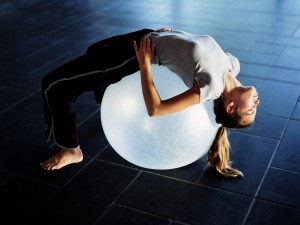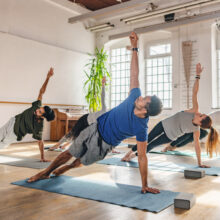Bend Before You Break: 3 Back Stretches to Try Now!
- Published: Monday, January 18th 2016
- in Fitness
by Kim Spencer, Owner of Fitness with Kim
Getting older can be rough. Getting older with chronic back pain is a lot rougher. But, the worst feeling is being mentally young when your stiff body feels fifty years older. How can we keep our bodies feeling and looking young, even as we age?
As you age, your muscles become shorter and tighter, making your body more prone to joint, tendon, and muscle injuries. Even if you’re not a fitness fanatic, stretching should still be a part of your daily life. Joints need to stay lubricated and motion is lotion for the joints. If we are not actively stretching our bodies, our joints can become inflamed, painfully stiff, and deformed. Our bodies then suffer from the effects of bad posture and we sometimes even cause arthritis to form or to grow worse.
When we don’t stretch, our muscles become tight. They lose their elasticity and, consequently, we use them less. This then causes even more tightness and weakness in the muscles, which leads to even more disuse. It’s a vicious cycle that will cause a lot more stiffness and pain as we age.
The moral of the story… Stretch! Stretch to save your body from breaking as you age.
Stretching not only prevents muscle and joint injury as you get older, it can also help you relieve stress and muscle tension. In our fast-paced world, keeping stress at a minimum is key to preventing our bodies from aging prematurely. When we’re under stress, our hearts beat faster, our muscles tighten, our breath shortens, and our senses become sharper… but only for a brief period of time. The long term effects of stress can wreak havoc on our bodies, causing symptoms ranging from memory loss and irritability to chronic aches and pains, frequent colds, eczema, constipation or diarrhea, and heart disease.
Taking a break to stretch can help us prevent breaking ourselves with stress.
When we slow down to stretch, we give our bodies a chance for that very important, basic function… breathing. Deep breathing oxygenates our muscles, calms our nerves, and helps our bodies relax. This increases blood flow to our muscles, allowing them to recover, whether it’s from a tough workout or a tough day at the office.
Slow down. Stretch. Take five to ten minutes (at least) every day to focus on your breathing and on your body. Inhale through your nose to filter out all the dust and impurities from the air. Also, inhaling through your nose helps regulate the air temperature and humidity for your lungs. Feel your breath flow into your diaphragm and your abdomen as you stretch deeply. Then, exhale through your mouth. Your exhaling should be slower than your inhaling because longer exhaling will allow your body to relax more fully into the stretches.
Be sure to stretch your whole body. Here are three easy full body stretches that you can do in your home or office. All you need is a standard chair and an exercise ball.
Backward Back Stretch
This full body stretch, not only increases your spine’s flexibility, but it also is a great chest and lung opener. If you’re into yoga, it also opens up your heart chakra. It’s an amazing stretch that can help reverse the effects of sitting at a desk for too long.
Primary Muscular Focus: Spine Flexibility, Core, Chest, and Psoas Muscles
- Sit on your exercise ball, with your feet firmly planted on the floor and your knees bent.
- Inhale, tuck your pelvis and slowly walk your feet forward, rolling the exercise ball to your lower to mid back onto the exercise ball, making sure that your spine is comfortably conforming to the curve of your exercise ball.
- Push your feet into the floor and allow your legs to straighten as you reach your arms back by your ears, and allow them to dangle behind your head as you relax over the ball.
- Hold the stretch and breathe for a minimum of 10 long breaths. The more you relax, the better the stretch!
Side Stretch
Feel the stretch in your obliques and through your ribcage as you allow your body to reach from feet to fingertips, actively stretching over your exercise ball.
Primary Muscular Focus: External Obliques, Internal Obliques, Core, Intercostals, Shoulder Stabilizers, Spinal Extensors, Psoas, Multifidus Muscles
- Lying on your exercise ball sideways, with your ribcage, waist, and hips keeping contact with the ball. Place your hand on floor to stabilize, with your top leg on the floor behind you and your bottom leg in front.
- Reach your top arm overhead while reaching the top leg long to stretch your entire side body.
- Hold for at least 10 long breaths, focusing on “puffing up” the top side of your ribcage to deepen the side stretch.
- Then, carefully, roll off the exercise ball.
Chair Stretch
This is the easiest stretch in the book… and the most relaxing! Do this stretch a few times throughout the day at the office or at home, not only for your back to relax, but your mind too. Use this even as your morning or mid-day meditation.
Primary Muscular Focus: Spine Flexibility, Exernal Shoulder Rotation
- Lying on your back on the floor, place your legs on the chair at a 90 degree bend: 90 degree bend at your hips and 90 degree bend at your knees. Leave your arms at your side at a 45 degree angle away from your body, with your palms rotated up to the sky and your thumbs reaching toward the floor.
- Hold for at least 5 minutes, breathing deeply, allowing your pelvis to settle into the ground and your back to relax. Close your eyes if you like and just relax, feeling your upper body “melt” into the floor.
- When you’re ready, slowly pull your legs off the chair and into your chest, as you roll to your side
Happy stretching!






